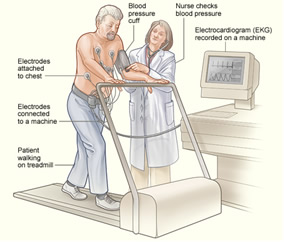EXERCISE STRESS TESTING
Our mission is to improve the health and well-being of our Bay Area residents through integrated and compassionate patient care, education and research.
Welcome new doctors
Upgraded new patient portages
Redesigned website
Exercise Stress Testing
Exercise Stress Testing
When your heart is at rest, it may get enough blood through the coronary arteries, even if the arteries are narrowed or blocked. However, during stress or activity, your heart may not be getting the extra blood and oxygen it needs. Physicians can use several techniques to evaluate heart performance under stress.
An electrocardiogram (EKG) detects and records electrical impulses created by your heart each time it beats. An echocardiogram provides an ultrasound image of the heart’s size and movements in addition to measuring electrical impulses. Performing these tests before, during, and after physical stress allows a doctor to:
- Identify heart-related causes of symptoms such as dizziness, fainting, or palpitations that occur during stress.
- Screen for coronary artery disease (CAD) in people without symptoms but with risk factors for the disease, such as smoking, high cholesterol, high blood pressure, diabetes, or a family history of heart disease at a young age.
- Investigate unexplained chest pain when CAD is suspected.
- Determine the heart’s ability to tolerate stress following a heart attack or prior to surgery.
- Monitor the effectiveness of medication, surgery, or other therapy.
- Recommend an appropriate level of exercise for someone who is over 40, has led an inactive lifestyle, and wishes to begin an exercise program.
Patient preparation
Before a stress electrocardiogram or echocardiogram test, inform your doctor of all medications you are taking. Discuss any physical limitations, including joint problems in your legs or hips that may limit your ability to exercise. If you have diabetes, ask your doctor for further instructions.
- On the day of your test, follow these instructions, unless your physician instructs you otherwise:
- Do not eat, drink or smoke for 2-4 hours prior to your test. Small sips of water are allowed.
- Do not take any medication the day of your test unless you have recently had cardiac surgery or experienced a heart attack, in which case you should take your medications as usual.
- Wear comfortable clothes and walking shoes.
- Be sure to bring a list of your current medications to the appointment.
Treadmill Stress Test (Stress EKG)
This test is performed at three-minute intervals before, during, and after you exercise on a treadmill. It records the electrical impulses produced by your heart each time it beats.
What to expect:
The technician will place electrodes on several areas of your arms, legs, and chest. The electrodes transmit your heart’s activity through wires to the EKG machine, where it will be displayed on a monitor and traced onto paper or stored in a computer. A blood pressure cuff on your upper arm will take blood pressure readings every few minutes during the test.
Your resting vital signs and a resting EKG are first taken as a precaution to ensure there are no signs that the test is unsafe for your heart.
You will begin by walking on the treadmill, and gradually increase the intensity of your exercise with speed and incline. Every 3 minutes an EKG reading will be taken.
After exercising, you will be asked to rest for 5 to 10 minutes as recovery EKG and blood pressure measurements are taken. This procedure lasts about 15 – 30 minutes.
Stress Echocardiogram (Stress Echo)
This test is like Stress EKG, with the addition of visual imagery. It is done before and during or immediately after physical exercise on a treadmill. It allows a physician to see the motion of the heart walls and pumping action when the heart is stressed.
What to expect:
Several electrodes will be attached to your chest for the EKG reading. Your oxygen levels will also be monitored. Ultrasound images of your heart’s resting function are taken prior to exercise.
Your resting vital signs and a resting EKG are first taken as a precaution to ensure there are no signs that the test is unsafe for your heart.
Next you will run or walk on a treadmill to elevate your heart rate. As you exercise, your heart’s electrical activity is recorded and displayed by the EKG machine. Every few minutes a cuff on your upper arm will measure your blood pressure.
After exercising, you will be asked to rest for 5 to 10 minutes as recovery EKG and blood pressure measurements are taken. This procedure lasts about 30 – 45 minutes.
Both tests continue until:
- You reach your maximum heart rate
- You need to stop
- You begin to show symptoms such as fatigue, extreme shortness of breath or chest pain
- The EKG shows evidence of decreased blood flow to the heart muscle
If at any time during either test you feel cramps, soreness, fatigue, shortness of breath, dizziness, dry mouth, or chest discomfort, tell the technician.
Risks
Electrocardiography and echocardiography are harmless. The exercise is similar to jogging up a hill and is safe for most people; however, emergency equipment and trained personnel are available in the testing area in the event of complications. Your vital signs are monitored throughout the test. There are several severe heart and lung conditions for which stress testing is not appropriate. Your doctor should be made aware of all health considerations before these tests are ordered.
Test results
Your cardiologist will discuss the test results with you and a report will be mailed to your primary care physician.
